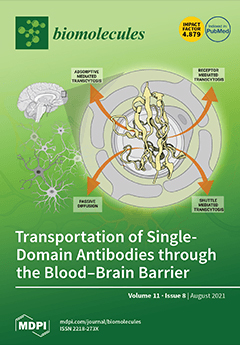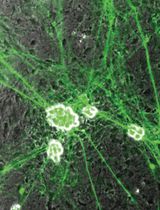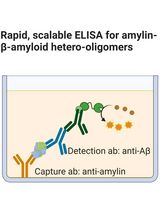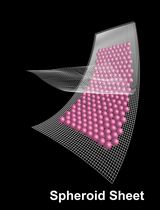- EN - English
- CN - 中文
Protocol for 3D Bioprinting Mesenchymal Stem Cell–derived Neural Tissues Using a Fibrin-based Bioink
使用基于纤维蛋白的生物墨水对间充质干细胞衍生的神经组织进行3D生物打印的方案
(*contributed equally to this work) 发布: 2023年05月05日第13卷第9期 DOI: 10.21769/BioProtoc.4663 浏览次数: 2866
评审: Oneil Girish BhalalaXinlei Li
Abstract
Three-dimensional bioprinting utilizes additive manufacturing processes that combine cells and a bioink to create living tissue models that mimic tissues found in vivo. Stem cells can regenerate and differentiate into specialized cell types, making them valuable for research concerning degenerative diseases and their potential treatments. 3D bioprinting stem cell–derived tissues have an advantage over other cell types because they can be expanded in large quantities and then differentiated to multiple cell types. Using patient-derived stem cells also enables a personalized medicine approach to the study of disease progression. In particular, mesenchymal stem cells (MSC) are an attractive cell type for bioprinting because they are easier to obtain from patients in comparison to pluripotent stem cells, and their robust characteristics make them desirable for bioprinting. Currently, both MSC bioprinting protocols and cell culturing protocols exist separately, but there is a lack of literature that combines the culturing of the cells with the bioprinting process. This protocol aims to bridge that gap by describing the bioprinting process in detail, starting with how to culture cells pre-printing, to 3D bioprinting the cells, and finally to the culturing process post-printing. Here, we outline the process of culturing MSCs to produce cells for 3D bioprinting. We also describe the process of preparing Axolotl Biosciences TissuePrint - High Viscosity (HV) and Low Viscosity (LV) bioink, the incorporation of MSCs to the bioink, setting up the BIO X and the Aspect RX1 bioprinters, and necessary computer-aided design (CAD) files. We also detail the differentiation of 2D and 3D cell cultures of MSC to dopaminergic neurons, including media preparation. We have also included the protocols for viability, immunocytochemistry, electrophysiology, and performing a dopamine enzyme-linked immunosorbent assay (ELISA), along with the statistical analysis.
Graphical overview

Background
Parkinson’s disease (PD) occurs due to the depletion of dopaminergic neurons (DNs) in the substantia nigra pars compacta, which causes patients to lose their motor skills (Dauer and Przedborski, 2003). Three-dimensional bioprinting has become a sought-after technique to obtain models of such diseases, as they are low-cost and reproducible when compared to animal models, and enable a personalized medicine approach to modeling PD. 3D bioprinting deposits a cell-laden bioink in a layer-by-layer fashion using a computer-aided design (CAD) model to determine the structure with the goal of mimicking the extracellular matrix and 3D organization of cells as found in vivo (Maan et al., 2022). 3D bioprinting allows for a more accurate physiological representation of human tissues than those of 2D cell culture models. Thus, the printed models can be used as a tool for in vitro drug screening and can improve the translation between in vitro and in vivo studies (Hamadjida et al., 2019).
Bioprinting cell-laden bioinks requires large numbers of cells that must be able to withstand the stresses inherent to the bioprinting process. Mesenchymal stem cells (MSCs) derived from adipose tissue are an attractive cell type for tissue engineering as they can be obtained from patients in large numbers, while withstanding the shear stress of 3D bioprinting due to their robust characteristics (Tasnim et al., 2018). A 2011 study by Trzaska & Rameshwar differentiated bone marrow MSCs to DNs using 2D cell culture in 12 days (Trzaska and Rameshwar, 2011). In this paper, we modified the Trzaska & Rameshwar protocol by changing the sonic hedgehog to its agonist (purmorphamine) and adding both LDN-193189 (LDN) and SB431542 (SB). Bioprinted MSC-derived DN models could aid in drug discovery and enhance the chance of finding new treatments for neurological disorders like PD. In addition, bioprinted patient-derived MSC models can be used to study disease progression and to determine the most suitable treatment plan specific to each patient. Accordingly, 3D bioprinted tissue models play an important role in neural tissue engineering, especially with patient-derived stem cells that enable personalized medicine.
Human MSCs have previously been bioprinted for cartilage tissue engineering (Gao et al., 2017; Govindharaj et al., 2022). However, these articles lack detailed methodology of the bioprinting process required for other research groups to easily replicate the protocol and results. Our group has published methods describing how to make a fibrin-based bioink and how to print on the Aspect Biosystems RX1 bioprinter (Abelseth et al., 2019). However, this protocol uses stem cell–derived neural aggregates rather than a single-cell suspension, and the printing and culture parameters change depending on the cell type. Other protocols have been published on how to print with the CELLINK BIO X bioprinter, but do not explain the culture criteria and differentiation conditions for any specific cell line (Chrenek et al., 2022). Our protocol integrates several protocols into one by bridging the gap in current literature—describing how to bioprint on two different types of bioprinters, the Aspect RX1 and CELLINK BioX, how to culture MSCs before bioprinting, how to perform the preliminary cell differentiation experiments prior to bioprinting, and how to maintain and differentiate the 3D models after bioprinting. The procedures for immunocytochemistry, viability, electrophysiology, and ELISA are described in detail in this methods paper. This protocol serves as a foundation on how to bioprint other cell types such as human-induced pluripotent stem cells or a primary cell line. Although this protocol utilizes a cell-laden bioink, a cell-free scaffold can also be created using only bioink and seeding cells after the bioprinting process. Finally, this protocol describes bioprinting with an extrusion-based bioprinter, but other bioprinters could potentially be used, such as inkjet-based printers. In this case, preliminary tests without cells are required to determine the optimal printing parameters. Overall, this protocol aims to provide a standardized method for both the bioprinting of MSCs and the analysis of the bioprinted 3D tissue models.
Materials and Reagents
Human adipose–derived mesenchymal stem cells (HMSC-AD) (ScienCell, catalog number: 7510); storage: liquid nitrogen
Phosphate-buffered saline (PBS) (Fisher Scientific, catalog number: 10010031); storage: room temperature (RT)
Fibronectin (ScienCell, catalog number: 8248); storage: -80 °C. Aliquot the reagent into working volumes prior to storing
Mesenchymal stem cell growth supplement and basal medium (complete kit) (ScienCell, catalog number: 7501); storage: -20 °C, protect from light
Trypan blue (0.4%) (Thermo Fisher, catalog number: 15250061); storage: RT
Trypsin-ethylenediaminetetraacetic acid (EDTA) (Thermo Fisher, catalog number: 25200056); storage: -20 °C. Aliquot the reagent into working volumes
Fetal bovine serum (FBS) (Thermo Fisher, catalog number: 12483020); storage: aliquot into working volumes and store at -20°C
Dulbecco’s phosphate-buffered saline (DPBS) (Thermo Fisher, catalog number: 14040117); storage: RT
Dimethyl sulfoxide (DMSO) (Sigma-Aldrich, catalog number: 472301); storage: RT, protect from light
Poly-L-ornithine (PLO) (Sigma-Aldrich, catalog number: P4957); storage: 4 °C
Dulbecco’s modified Eagle medium (DMEM), high glucose, no glutamine (Sigma-Aldrich, 11-960-044); storage: 2–8 °C, protect from light
Laminin (Sigma-Aldrich, catalog number: L2020); storage: -20 °C. Aliquot the reagent into working volumes. Avoid thaw/freeze cycles
Neurobasal media (Thermo Fisher, catalog number: 21103049); storage: 4 °C, protect from light
B-27 supplement (50×), serum free (Thermo Fisher, catalog number: 17504001); storage: -20 °C, protect from light. Aliquot the reagent into working volumes. Avoid thaw/freeze cycles
GlutaMAXTM supplement (Thermo Fisher, catalog number: 35050061); storage: RT, protect from light
Penicillin-streptomycin (Sigma-Aldrich, catalog number: P4333); storage: -20 °C. Aliquot the reagent into working volumes. Avoid thaw/freeze cycles
Purmorphamine (Sigma-Aldrich, catalog number: SML0868); storage: -20 °C. Aliquot the reagent into working volumes. Avoid thaw/freeze cycles
Fibroblast growth factor 8 (FGF8) (R&D Systems, catalog number: 423-F8-025); storage: -80 °C. Aliquot the reagent into working volumes. Avoid thaw/freeze cycles
LDN-193189 (STEMCELL Technologies, catalog number: 72147); storage: -20 °C. Aliquot the reagent into working volumes. Avoid thaw/freeze cycles
SB431542 (STEMCELL Technologies, catalog number: 72232); storage: -20 °C. Aliquot the reagent into working volumes. Avoid thaw/freeze cycles
Brain-derived neurotrophic factor (BDNF) (PeproTech, catalog number: 450-02); storage: -20 °C. Aliquot the reagent into working volumes. Avoid thaw/freeze cycles
TissuePrint-HV Kit (Axolotl Bioscience); storage: -20 °C. Use for BIO X Printer
TissuePrint-LV Kit (Axolotl Bioscience); storage: -20 °C. Use on Aspect RX1 printer
TissuePrint Crosslinker (Axolotl Bioscience); storage: -20 °C. Use for both BIO X and Aspect RX1 printer
LIVE/DEAD Viability/Cytotoxicity kit (Thermo Fisher, catalog number: L3224); storage: -20 °C, protect from light
Formalin solution, neutral buffered, 10% (Sigma-Aldrich, catalog number: HT501128); storage: RT
Triton X-100 (Sigma-Aldrich, 9036-19-5); storage: RT
Normal goat serum (Abcam, catalog number: ab7481); storage: -20 °C. Aliquot the reagent into working volumes. Avoid thaw/freeze cycles
Primary antibody: anti-tyrosine hydroxylase (TH) antibody - neuronal marker (Abcam, catalog number: ab1120); storage: -20 °C. Aliquot reagent into working volumes. Avoid multiple freeze/thaw cycles
Primary antibody: anti-beta-III tubulin (TUJ1) antibody - neuron specific (R&D Systems, catalog number: MAB1195); storage: -20 °C. Aliquot reagent into working volumes. Avoid thaw/freeze cycles
Secondary antibody: goat anti-mouse (Alexa Fluor® 488) (Thermo Fisher, catalog number: D1306); storage: 4 °C, protect from light
Secondary antibody: goat anti-rabbit (Alexa Fluor® 568) (Thermo Fisher, catalog number: A11011); storage: 4 °C, protect from light
DAPI (Thermo Fisher, catalog number: D1306); storage: -20 °C (stock solution) or 4 °C (diluted solution). Avoid multiple freeze/thaw cycles
FLIPR Membrane Potential Assay Kit Blue (Molecular Devices, catalog number: R8042); storage: component A: RT; component B: 4 °C
Potassium chloride (KCl) (Caledon, catalog number: 5920170); storage: RT
Dopamine-specific enzyme-linked immunoassay (ELISA) kit (Abnova, catalog number: KA3838); storage: 4 °C
Cryovials (STEMCELL Technologies, catalog number: 200-0555)
T-75 flask, tissue culture treated
50 mL and/or 15 mL conical, sterile
Various sizes of pipette tips (1,000 μL, 200 μL, 20 μL), sterile and filtered
Kimwipes (Fisher Scientific, catalog number: 66662)
Corning® CoolCell® containers (Cole Palmer, catalog number: RK-04392-00); storage: RT/-80 °C
12-well cell culture plate (Sigma-Aldrich, catalog number: M8687)
LOP printhead (Aspect Biosystems, catalog number: 1256)
Mesh, square, 50 × 50 mm, pack of 10 (Aspect Biosystems, catalog number: 2067)
RX1 tubing, 74 cm (Aspect Biosystems, catalog number: 7779)
RX1 tubing, 54 cm (Aspect Biosystems, catalog number: 7777)
Empty cartridges without end and tip caps, 3 mL (CELLINK, catalog number: CSC010300502)
Sterile standard conical bioprinting nozzles, 22 G (CELLINK, catalog number: NZ4220005001)
Female/female luer lock adapter (CELLINK, catalog number: OH000000010)
5 cc luer lock syringe w/o needle (Terumo Medical Corporation, catalog number: SS-05L)
Various sizes of serological pipettes (25, 10, 5, and 1 mL)
Liquid nitrogen dewar
Control Group Cell Culture media (see Recipes)
Experimental Cell Culture media (see Recipes)
Complete Mesenchymal Stem Cell (MSC) medium (see Recipes)
Diluting PLO in PBS (see Recipes)
Diluting laminin in DMEM (see Recipes)
Calcein AM and Ethidium Homodimer-1 solution (see Recipes)
0.1% Triton-X solution (see Recipes)
5% NGS solution (see Recipes)
Primary Antibody solution (see Recipes)
Secondary Antibody solution (see Recipes)
300 nM DAPI solution (see Recipes)
70% ethanol solution (see Recipes)
Potassium chloride solution (see Recipes)
10% DMSO Freezing Media solution (see Recipes)
Equipment
BIO X printer (CELLINK, S-10001-001)
RX1 bioprinter (Aspect Biosystems, 46135)
DMI3000B microscope (Leica)
X-Cite Series 120Q Fluorescent light source (Excelitas Technologies, XI120-Q)
FormaTM Steri-CycleTM CO2 incubator (Thermo Fisher, 370)
Infinite M200 Pro Plate Reader (TECAN, 30050303)
Confocal Laser scanning microscope (FIPS-Zeiss) 10× and 20× magnification
Retiga 2000R digital CCD camera (QImaging)
Biosafety cabinet (BSC)
Water bath (VWR, 89032-299)
Lab ArmorTM beads (Thermo Fisher, A1254301)
Centrifuge 5810 R (Eppendorf, 5811000015)
-80 °C freezer
Pipette controller
DeNovix CellDrop FL (DeNovix CellDrop FL)
Software
Qcapture software 2.9.12
Excel (Microsoft)
ImageJ V1.52a
Prism 5 (GraphPad) statistical software
Procedure
文章信息
版权信息
© 2023 The Author(s); This is an open access article under the CC BY license (https://creativecommons.org/licenses/by/4.0/).
如何引用
Restan Perez, M., Masri, N. Z., Walters-Shumka, J., Kahale, S. and Willerth, S. M. (2023). Protocol for 3D Bioprinting Mesenchymal Stem Cell–derived Neural Tissues Using a Fibrin-based Bioink. Bio-protocol 13(9): e4663. DOI: 10.21769/BioProtoc.4663.
分类
生物工程 > 生物打印
神经科学 > 基础技术 > 高通量筛选
细胞生物学 > 细胞工程 > 组织工程
您对这篇实验方法有问题吗?
在此处发布您的问题,我们将邀请本文作者来回答。同时,我们会将您的问题发布到Bio-protocol Exchange,以便寻求社区成员的帮助。
Share
Bluesky
X
Copy link












